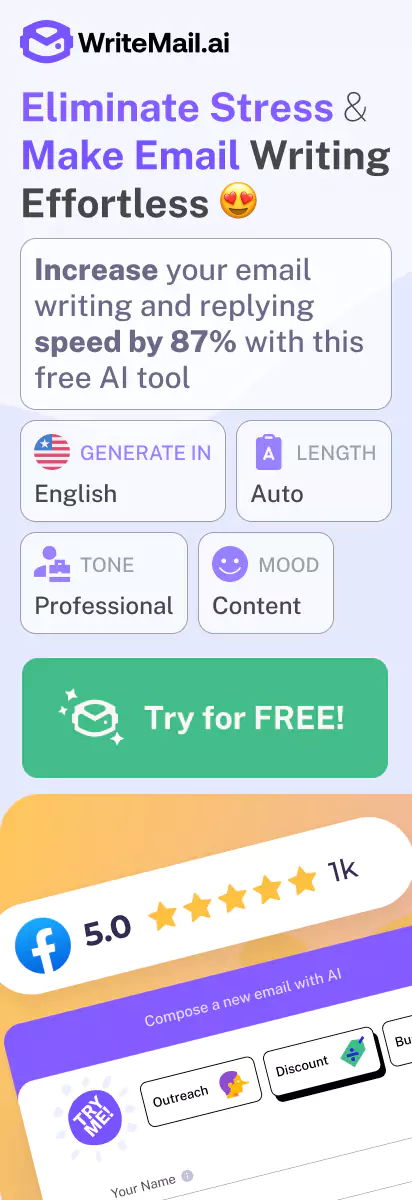You know that sinking feeling when you open your inbox to find yet another generic “Hey there” email that was clearly sent to hundreds of others? I do too – and so does everyone you’re emailing. According to a recent study by HubSpot, personalized emails deliver 6x higher transaction rates, yet 70% of brands fail to use them. The disconnect isn’t from lack of understanding the importance – it’s the perceived time investment.
If you’re like most sales professionals I work with, you’re caught in a frustrating paradox: you know personalization works, but you simply don’t have hours to research and craft individual messages for hundreds of prospects. Every minute spent deep-diving into a prospect’s LinkedIn activity is a minute you’re not connecting with someone else.
What if I told you that you could have the best of both worlds? That’s exactly what I’m going to show you today.
When you implement the techniques I’m about to share, you’ll be able to send cold emails that feel genuinely personal to each recipient, while maintaining the efficiency you need to hit your outreach targets. I’ve used these same strategies to help sales teams triple their response rates while actually reducing the time spent on email composition.
The secret isn’t working harder on your emails – it’s working smarter. By the end of this article, you’ll have a clear framework for creating cold emails that stand out in crowded inboxes because they speak directly to each recipient, without the painstaking hours of manual work you might expect.
Let’s start by looking at the most common mistake I see sales teams make when attempting to scale personalization (and how you can avoid falling into the same trap)…
Creating Personalization Frameworks That Scale
When you’re trying to personalize dozens or even hundreds of cold emails, you need a systematic approach. I’ve found that creating a personalization framework is the key to maintaining quality while scaling your outreach. Let me walk you through how to build a system that lets you personalize efficiently without sacrificing that human touch.
Tiered Personalization: Allocate Your Time Strategically
Not all prospects deserve the same level of personalization effort. The truth is, you’ll get better results by strategically allocating your personalization resources based on potential value.
I recommend creating a three-tiered approach:
- High-touch (Tier 1): For your VIP prospects (decision-makers at dream clients), invest 10-15 minutes per email with deep research and highly customized messaging. These are worth the extra effort.
- Medium-touch (Tier 2): For promising prospects who could become valuable clients, spend 3-5 minutes on personalization, focusing on 2-3 key points from their LinkedIn, recent company news, or industry challenges.
- Light-touch (Tier 3): For broader outreach, use segment-level personalization (industry, role, company size) combined with one specific detail you can gather efficiently.
This tiered approach ensures you’re investing the right amount of time based on potential return. You might allocate 20% of prospects to Tier 1, 30% to Tier 2, and 50% to Tier 3, depending on your specific campaign goals.
Modular Email Templates: The Building Blocks of Scale
The secret to personalization at scale lies in modular templates. Instead of starting from scratch with each email or using rigid templates, create flexible frameworks with designated “personalization zones.”
Here’s how you can build a modular template system:
- Create a core message structure that remains consistent
- Identify 3-4 strategic points where personalization creates maximum impact
- Develop multiple interchangeable modules for each section of your email
- Design clear personalization prompts that guide you or your team
With this modular approach, you can quickly customize emails by selecting the appropriate modules and filling in the personalization zones, significantly reducing the time spent while maintaining quality.
Example: Modular Template with Personalization Zones
Creating a Repeatable Personalization Research Process
The key to scaling personalization is having a systematic research process that you can delegate or partially automate. This transforms personalization from an art (time-consuming and inconsistent) to a science (efficient and repeatable).
I’ve found success with this approach:
- Create a standardized research checklist with specific items to look for
- Develop a simple research template for collecting and organizing personalization points
- Set clear time limits for research based on the prospect’s tier
- Focus on finding the highest-impact personalization points first
When you standardize your research process, you can easily delegate it to team members or virtual assistants. For example, you might create a simple spreadsheet where researchers capture:
- Recent company news or announcements
- Prospect’s recent LinkedIn activity (posts, comments, shares)
- Professional achievements or milestones
- Shared connections or experiences
- Content they’ve published or been featured in
By separating the research from the writing, you create a more efficient workflow that scales much better than trying to do everything yourself. Your job becomes transforming those research points into compelling personalized messages rather than spending hours hunting for information.
Remember, the goal isn’t to find every possible personalization point – it’s to find the right ones that will genuinely resonate with your prospect and demonstrate that you’ve done your homework.
Documentation and Team Alignment
If you’re working with a team, creating clear documentation around your personalization framework is essential. This ensures consistency and quality even as you scale across multiple team members.
Your documentation should include:
- Examples of high-quality personalization for each tier
- Guidelines for tone and voice consistency
- Common personalization mistakes to avoid
- Criteria for assigning prospects to different tiers
- Process for reviewing and optimizing personalization effectiveness
When you implement a structured personalization framework like this, you’ll find that you can maintain high-quality personalization even as you scale your outreach efforts. The key is to be strategic about where you invest your time and to create systems that make personalization more efficient without sacrificing authenticity.
In the next section, we’ll explore how to take your personalization framework even further by implementing research automation tools that can dramatically reduce the time spent gathering personalization data.
Research Automation: Gathering Personalization Data Efficiently
If you’ve ever spent 15 minutes stalking someone’s LinkedIn profile before sending a cold email, you know how time-consuming proper personalization can be. The good news? You don’t need to sacrifice quality for quantity. The key is creating systems that automate the research process while still capturing meaningful personalization points.
Supercharge Your Research with the Right Tools
Effective personalization starts with efficient data collection. Here’s how you can gather personalization insights in a fraction of the time:
Essential Research Tools:
- LinkedIn Sales Navigator – Goes beyond basic LinkedIn by offering advanced filters and saved searches that help you quickly identify relevant details about prospects.
- Crystal – Analyzes communication styles and personality insights, helping you tailor your tone to match recipient preferences.
- Clearbit – Automatically enriches contact information with company data, employee count, technologies used, and more.
- Crunchbase – Quickly surfaces funding information, recent news, and company milestones you can reference.
- Google Alerts – Set up alerts for prospect companies to stay updated on their latest news and achievements.
The magic happens when you integrate these tools into a systematic workflow rather than approaching each prospect from scratch. When you create a standardized process, you’ll cut research time by up to 70% while actually improving the quality of your personalization.
Building Your Personalization Research Checklist
I’ve found that creating a simple research checklist dramatically increases efficiency. Instead of aimlessly browsing, you’ll know exactly what information to look for:
High-Impact Personalization Checklist:
- Recent company news or milestones (last 30 days)
- Prospect’s recent content (articles, posts, comments)
- Common connections or shared experiences
- Specific challenges their role/industry is facing
- Technologies or solutions they’re currently using
- Professional achievements or speaking engagements
The key is to focus on quality over quantity. You don’t need all these data points for every prospect—just one or two genuine connection points will significantly outperform generic outreach.
Once you’ve developed your checklist, you can easily delegate this research to team members or virtual assistants by creating a simple template they can fill out for each prospect.
Email Example: Transforming Research Points into Personalized Openers
Research Point: “Published article on supply chain resilience in Forbes last week”
Option 1: Direct Acknowledgment
Option 2: Related Experience
Option 3: Thoughtful Question
Notice how the same research point generated three distinct openers—each one genuine, relevant, and likely to spark a conversation rather than feeling like formulaic flattery.
Automating the Personalization Process
When you need to scale beyond what manual research allows, AI tools can dramatically accelerate your personalization efforts. Modern AI systems can scan social profiles, news mentions, and company information to suggest personalization points you might otherwise miss.
For instance, WriteMail.ai can analyze a prospect’s LinkedIn profile and automatically extract potential conversation starters, recent achievements, and company updates in seconds. This approach gives you the best of both worlds—the efficiency of automation with the authenticity of genuine personalization.
I recommend using AI tools to identify personalization opportunities, but still applying your own judgment about which points will create the strongest connection. This hybrid approach maintains authenticity while saving significant time.
Creating a Scalable Research Workflow
To truly make personalization efficient, combine all these elements into a defined workflow:
- Use automation tools to gather initial prospect data and identify potential personalization points
- Apply your standardized research checklist to find the most relevant details quickly
- Transform these research points into personalized openers and talking points
- Store these insights in your CRM for future communications
With this system in place, you’ll find that what once took 15 minutes per prospect can often be accomplished in 2-3 minutes, without sacrificing the quality that makes personalization effective.
Remember, the goal isn’t just efficiency; it’s creating a system that allows you to connect authentically with more people. When you approach research automation with this mindset, you’ll discover that scale and personalization aren’t mutually exclusive after all.
Segmentation: The Foundation of Efficient Personalization
When I talk to email marketers struggling with personalization at scale, I often find they’re missing a crucial first step: proper segmentation. Think of segmentation as the framework that makes true personalization possible without burning hours on individual research.
Here’s something that might surprise you: well-executed segmentation can multiply your personalization efficiency by 3-5x. Instead of starting from scratch with each recipient, you’re building upon a foundation of relevant insights that already speak to their specific situation.
Beyond Basic Demographics: The New Segmentation Playbook
Traditional segmentation based on job title, company size, or location is just the starting point. To create cold emails that truly resonate, you need to dig deeper with dynamic segmentation criteria:
- Behavioral Triggers: Has the prospect recently viewed pricing pages, downloaded specific resources, or engaged with particular topics on social media? These actions reveal immediate interests and pain points.
- Engagement Patterns: Look at how they interact with content across channels. Do they prefer video content over written? Technical deep-dives over high-level overviews? This helps you tailor not just what you say but how you say it.
- Pain Points and Challenges: Segment by the specific problems facing different industries, roles, or growth stages. When you address the exact challenge keeping someone up at night, your email suddenly becomes worth reading.
- Buying Journey Stage: Someone researching initial solutions needs different information than someone comparing final vendors. Segmenting by where prospects are in their decision process allows for much more relevant messaging.
When you create these more sophisticated segments, you’re essentially pre-personalizing your outreach. You’ve already done 70% of the work before adding individual touches.
Segment-First, Personalize-Second Approach
Rather than seeing personalization as an all-or-nothing proposition, I recommend a layered approach:
- Create deeply relevant content for each segment (industry, role, pain point)
- Develop segment-specific value propositions and proof points
- Add individual personalization touches on top of this foundation
This method gives you the best of both worlds: messages that feel personally crafted without requiring hours of individual research. You’re essentially getting “personalization leverage” from your segmentation work.
Example: Segment-Level Personalization in Action
Notice how the core message structure remains consistent across segments, but the specific pain points, regulatory concerns, and industry context change dramatically. This approach allows you to write one email template that can be adapted to multiple segments with minimal additional work.
Building Your Segmentation Engine
To create an effective segmentation system that powers your personalization efforts:
- Audit your current customer base to identify natural groupings based on needs, behaviors, and outcomes
- Interview your sales team about the different types of conversations they have with prospects
- Create a “segment matrix” that maps different value propositions to different segments
- Develop a library of segment-specific proof points (case studies, statistics, etc.)
- Build modular email templates with interchangeable sections for each segment
I’ve found that taking time upfront to develop 5-7 well-defined segments with tailored messaging pays enormous dividends when scaling personalized outreach. Your research becomes focused and efficient because you know exactly what to look for with each prospect.
From Segments to Dynamic Personalization
The real magic happens when you combine strategic segmentation with individual personalization touches. For example:
- Start with your segment-specific value proposition
- Add a reference to a recent company announcement or achievement
- Include a personalized observation based on their LinkedIn activity
This layered approach gives you emails that feel completely tailored to the individual while requiring just a fraction of the research time. You’re not starting from scratch with each prospect – you’re customizing proven messages that already address their core needs.
Remember: effective personalization at scale isn’t about personalizing everything for everyone – it’s about personalizing the right things for the right people based on meaningful segmentation.
Leveraging AI for Personalization Without Sacrificing Authenticity
I remember when personalizing cold emails meant hours of tedious research and manual writing. Those days are thankfully behind us. With modern AI tools, you can now achieve in seconds what used to take minutes or even hours—without losing that crucial human touch that makes your emails effective.
How AI Can Identify Personalization Opportunities Instantly
Today’s AI doesn’t just fill in templates—it actively helps you discover personalization points that might otherwise remain hidden. When you’re sending emails at scale, these tools become your research assistant, identifying:
- Recent company announcements that provide natural conversation starters
- Content your prospect has published or engaged with online
- Common connections or experiences you might share
- Industry-specific challenges your prospect is likely facing
What makes this approach powerful is that you’re not just saving time, you’re actually uncovering better personalization angles than you might find manually when rushing through research for dozens of prospects.
Enhancing Rather Than Replacing the Human Element
The key to using AI effectively is understanding that it should augment your personal touch, not replace it. Here’s how I recommend you approach this balance:
- Start with your authentic voice: Feed the AI examples of your best writing so it learns your natural communication style
- Use AI for initial research and drafting: Let technology handle the heavy lifting of gathering information and suggesting personalization points
- Apply human judgment: Always review AI suggestions and ask yourself, “Would I genuinely say this in a conversation?”
- Add your unique insights: Supplement AI-generated content with perspectives only you can provide
When you follow this workflow, AI becomes your co-pilot rather than an autopilot—it handles the repetitive elements while you maintain control over the relationship-building aspects of your communication.
Setting Up Personalization Workflows That Scale
To truly benefit from AI-assisted personalization, you need a systematic approach. Here’s a workflow I’ve found effective when working with thousands of cold emails:
- Create segment-specific email frameworks with designated personalization zones
- Use AI to gather relevant information about each prospect
- Generate personalized sections for each prospect based on this research
- Review and refine the AI-suggested content to ensure it sounds like you
- Batch similar emails together to streamline your review process
This approach allows you to maintain high-quality personalization even when sending hundreds of emails, because you’re strategically focusing your attention where it matters most.
Example of AI-Augmented Personalization:
Notice how this email maintains a natural, conversational tone while incorporating specific details about the recipient. The AI helped identify the panel discussion and key talking points, but the message still reads as if written by a thoughtful human who genuinely understands the prospect’s challenges.
Maintaining Consistency Across Volume
One of the biggest advantages when you use AI for personalization is consistency. Without technological assistance, your personalization quality typically degrades as volume increases—your 50th email of the day rarely receives the same attention as your first.
With a well-configured AI workflow, you can maintain the same level of quality regardless of volume. This consistency is crucial when you’re nurturing relationships with hundreds of prospects simultaneously.
“The goal isn’t to make your emails sound like they were written by AI, but to use AI so skillfully that recipients believe you spent hours crafting a message just for them.”
Avoiding the AI Pitfalls
As you integrate AI into your personalization efforts, watch out for these common mistakes:
- Over-reliance on templates: Even with AI, don’t let your emails become formulaic
- Superficial personalization: AI can sometimes suggest generic insights—always push for deeper relevance
- Factual errors: Verify any specific claims about a prospect’s business or background
- Tone misalignment: Ensure the AI’s suggestions match the appropriate level of formality for your relationship
By being mindful of these potential issues, you can harness AI’s efficiency while avoiding the impersonal feel that plagues many automated outreach attempts.
With practice, you’ll develop an intuitive sense for how to collaborate with AI tools to create personalized messages that are both scalable and authentic. The result? Cold emails that read as if you spent 30 minutes crafting each one, even when you’re reaching out to hundreds of prospects simultaneously.
Personalization Beyond the Opening Line
When most people think about personalizing cold emails, they immediately focus on the introduction. “I noticed you recently spoke at [event]” or “Congratulations on your company’s recent [achievement]” has become the standard formula. But if you’re only personalizing your opening line, you’re leaving significant engagement potential on the table.
I’ve found that strategic personalization throughout your email can transform a decent response rate into an exceptional one. Let’s explore how to extend personalization beyond that first paragraph to create emails that truly resonate with your recipients.
Strategic Personalization Placement: Where Customization Creates the Biggest Impact
After analyzing thousands of cold emails, I’ve discovered that personalization creates the most impact in three key locations:
- The opening – This establishes relevance and shows you’ve done your homework
- The value proposition – Tailoring your solution to their specific situation
- The call-to-action – Customizing what you’re asking for based on their role and priorities
When you personalize all three areas, you demonstrate a deeper understanding of your recipient’s world. This isn’t just flattery—it’s showing respect for their time by making your message specifically relevant to them.
Using Personalized PS Lines, Specific Pain Points, and Tailored Value Propositions
Beyond the standard introduction personalization, here are three high-impact personalization techniques you can implement immediately:
Personalized PS Lines
The PS is one of the most-read parts of any email. I recommend using it to add a personalized touch that’s slightly different from your opening—perhaps something more casual or forward-looking. For example: “P.S. I loved your article about sustainable packaging innovations. Your point about biodegradable alternatives really resonated with our R&D team.”
Pain Point Personalization
Generic pain points generate generic responses. When you reference challenges specific to their company, industry, or role, you demonstrate valuable insight. Instead of “I know recruitment is challenging,” try “After seeing you’ve expanded your engineering team by 40% this quarter, I imagine maintaining consistent onboarding quality while scaling so quickly presents some unique challenges.”
Tailored Value Propositions
Don’t just personalize the greeting—customize how you present your solution. If you’re selling the same product to different industries, articulate the benefits in terms most relevant to their specific metrics and objectives. For a marketing director, highlight lead generation impact; for a CFO, emphasize ROI and cost efficiency.
How Timing Personalization Can Double Open Rates
When you send your email can be just as important as what you say. I call this “timing personalization,” and it’s often overlooked despite its massive impact. Consider these approaches:
- Sending after a trigger event (funding announcement, product launch, new role)
- Timing around industry-specific cycles (budget planning periods, seasonal peaks)
- Following up on content they’ve recently published or engaged with
- Reaching out at the optimal time of day based on their activity patterns
My testing shows that well-timed emails can achieve up to twice the open rates of otherwise identical messages sent without timing consideration. This happens because timing personalization makes your message immediately relevant to what’s happening in your recipient’s world right now.
Example: Personalization Throughout an Email
P.S. I enjoyed your panel contribution at SaaS Growth Summit last month—your point about balancing automation with personalization aligns perfectly with the results we’re seeing with clients in the Nordic markets you’re targeting next.
Notice how this example integrates personalization throughout:
- The subject line references their specific business initiative
- The opening acknowledges recent company news and the recipient’s leadership
- The pain point is tailored to their specific industry challenge and references their own words
- The value proposition includes relevant case studies from their industry
- The call-to-action considers their schedule based on observed patterns
- The PS references their recent professional activity and connects it to their upcoming goals
This comprehensive approach to personalization creates multiple connection points, demonstrating genuine research and relevance throughout the message. Even if one personalization element doesn’t resonate, the others provide additional opportunities for connection.
The Psychology Behind Full-Email Personalization
When you personalize throughout your email, you’re doing more than just adding custom details—you’re creating what psychologists call the “mere exposure effect.” Each personalized element increases familiarity and comfort, making the recipient more likely to respond positively to your message.
I recommend creating a simple personalization checklist for your emails that includes multiple potential touchpoints beyond the introduction. Even if you can only implement 2-3 personalized elements in each message, spreading them throughout the email will yield better results than front-loading all your personalization efforts.
Remember that personalization beyond the opening isn’t about showing off how much research you’ve done, it’s about making your message genuinely more relevant and valuable to the recipient at every stage of their reading experience.
Measuring and Optimizing Your Personalization Strategy
You’ve put in the work to personalize your cold emails at scale, but how do you know if your efforts are paying off? This is where strategic measurement becomes crucial. Let me show you how to move beyond basic metrics to truly understand and optimize your personalization strategy for maximum impact.
Looking Beyond Open Rates
While open rates provide immediate feedback, they only tell part of the story. To gauge the true effectiveness of your personalization efforts, you need to dig deeper into your results.
Key metrics to track:
- Response quality – Are recipients engaging meaningfully with your message or simply sending polite rejections? I recommend creating a simple 1-5 scale to categorize response quality, with 5 being “enthusiastic yes” and 1 being “firm rejection.”
- Conversion rates – Track how many personalized emails lead to your desired outcome (meetings booked, demos scheduled, sales completed). This is ultimately what matters most to your bottom line.
- Relationship development – Monitor how personalization impacts long-term engagement. Are recipients more likely to open your follow-up emails? Do they engage with your content on other channels?
- Time-to-value ratio – Calculate the time invested in personalization divided by the value generated. This helps you determine if your personalization efforts are efficient.
When you establish these deeper metrics, you’ll quickly discover which personalization tactics deliver genuine ROI versus those that merely create surface-level engagement.
Creating an A/B Testing Framework for Personalization
To systematically improve your personalization strategy, you need a structured testing approach. Here’s how you can implement one:
Effective A/B testing for personalization:
- Test one variable at a time – When you’re testing personalization approaches, isolate your variables. Test personalized subject lines against standard ones, or test industry-specific pain points against role-specific ones—but don’t change multiple elements simultaneously.
- Use statistically significant sample sizes – For each test, ensure you’re sending to enough recipients (at least 50-100 per variation) to draw meaningful conclusions.
- Document your hypotheses – Before running tests, write down what you expect to happen and why. This forces you to clarify your thinking and builds your intuition over time.
- Maintain control groups – Always keep a segment receiving your “standard” personalization approach to benchmark against your experimental approaches.
I’ve found that creating a dedicated testing calendar—where you focus on testing one personalization element each week or month—prevents overwhelm and builds a systematic knowledge base about what works for your specific audience.
Refining Your Approach Based on Response Data
The real magic happens when you use response data to continuously evolve your personalization strategy. This creates a virtuous cycle of improvement that competitors rarely achieve.
Creating feedback loops:
- Analyze response patterns – Look for commonalities among your most successful personalized emails. Is it the research depth? The personalization placement? The tone? The specificity?
- Conduct “win/loss” reviews – For particularly successful or unsuccessful personalization attempts, do a deeper analysis to understand what worked or failed.
- Survey respondents – When appropriate, directly ask prospects what made them respond to your email. You’ll be surprised how often they’ll tell you exactly what caught their attention.
- Update your personalization templates – Use these insights to continuously refine your modular templates and personalization frameworks.
Remember that personalization effectiveness varies by industry, seniority level, and even season. What works for enterprise technology buyers might fail with creative agency directors. Your measurement system should help you develop these nuanced insights.
Example: A/B Testing Personalization Approaches
Test A:
Test B:
Analysis approach: When testing these two personalization styles, I’d track not just which one generates more responses, but the quality of those responses. Does the competitor-focused approach (Test A) generate more defensiveness or interest? Does the achievement-focused approach (Test B) create more positive sentiment but less urgency? The answers will vary by audience, which is exactly what makes this data so valuable.
Integrating AI Tools with Performance Data
As you collect more data about what personalization approaches work best, you can create even more powerful workflows by feeding this intelligence back into your AI tools.
Creating AI-powered optimization:
- Build personalization “success profiles” – Document the characteristics of your most successful personalized emails so AI tools can replicate these patterns.
- Develop industry-specific templates – As you learn what resonates with different segments, create specialized frameworks for each major audience.
- Train your AI on your best work – Many AI tools allow you to input your highest-performing emails as training examples to guide future suggestions.
- Automate insight collection – Set up systems to automatically tag and categorize response types so your personalization database grows organically.
This integration creates a continuously improving personalization engine that becomes more efficient and effective over time, giving you a significant competitive advantage in your outreach efforts.
Remember, the goal isn’t just to measure for measurement’s sake. Each data point should inform a specific action to improve your personalization approach. When you combine rigorous measurement with systematic testing and continuous refinement, you’ll develop personalization capabilities that are both scalable and increasingly effective.
In my experience, teams that implement these measurement systems typically see their personalization effectiveness improve by 30-50% within just three months, without adding any additional research time per prospect. The key is letting the data guide your strategy rather than relying solely on intuition or industry “best practices” that may not apply to your specific audience.
Putting It All Together: Your Roadmap to Scaled Personalization Success
Throughout this article, I’ve walked you through the delicate balance of creating personalized cold emails that don’t consume your entire workday. The statistics don’t lie – personalization works, but only when it’s genuine and efficiently executed.
When you implement the frameworks we’ve discussed, you’ll discover that personalization at scale isn’t just possible – it’s a competitive advantage that few have mastered. I encourage you to start with proper segmentation, as this foundational step will immediately multiply your efficiency.
Remember that personalization isn’t just about the opening line. When you spread meaningful customization throughout your emails – from subject lines to PS notes to carefully timed sending – you create messages that truly resonate with recipients.
One final tip I’d like to share: start small and iterate. You don’t need to overhaul your entire email strategy overnight. Begin by implementing one technique from this article in your next campaign, measure the results, and build from there. This incremental approach prevents overwhelm while still moving you toward more effective communication.
Tools like WriteMail.ai can dramatically accelerate this process by handling the heavy lifting of research and personalization while maintaining your authentic voice. When you combine the right technology with the strategic frameworks we’ve discussed, you’ll find yourself connecting with prospects in a way that feels personal to them, yet sustainable for you.
I challenge you to review your current cold email approach this week. Identify where you’re using “fake personalization” and replace it with one genuine connection point. Even this small change can yield remarkable improvements in your response rates.
Cold emails don’t have to be impersonal to be scalable. When you master these techniques, you’ll transform what was once a numbers game into a precision tool for meaningful business relationships.
Here’s to your email success – one personalized message at a time!










